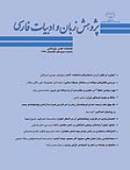تحلیل رمان چندآوایی «شطرنج با ماشین قیامت»
محورهای موضوعی : پژوهشهای ادبیات کلاسیک ایران
1 - دانشیار دانشگاه شهید باهنر کرمان
کلید واژه: شطرنج با ماشین قیامت حبیب احمدزاده رمان چندآوایی,
چکیده مقاله :
رمان شطرنج با ماشین قیامت، رمانی رئالیستی فلسفی است که ضمن اشاره به واقعیتهای نبرد ایران و عراق، دیالوگهای فلسفی و خردمندانه بین شخصیتها، کنجکاوی مخاطب را نسبت به دریافت و درک جواب پرسشهایی که درگیری ذهنی خود اوست برمیانگیزد. کارکردهای متفاوت زبان رمان، زمینۀ تأویلپذیری متن را - خصوصاً وقتی به سمت دلالتهای ضمنی و غیر صریح پیش میرود - فراهم کرده است. از سوی دیگر بحث و جدلهای لفظی دربارۀ بازی شطرنج و تطبیق آن با صحنۀ زندگی آدمیان، تکگوییهای درونی راوی، چرخشهای زمانی و پاسخ و پرسشهای فلسفی و کلامی دربارۀ آغاز آفرینش، جبر و اختیار و پدیدههای محیطی، رمانی «چندآوایی» را آفریده است. در این پژوهش، نویسنده نداهای متفاوت اندیشه، زمان، رؤیا و بازی را در رمان «شطرنج با ماشین قیامت»، بر اساس نظر «میلان کوندرا» به شیوۀ توصیفی- تحلیلی تبیین میکند و به لحاظ اهمیت ماهیت زبان رمان، به کارکردهای زبان رمان و دلالتهای نشانهشناختی که زمینۀ چندآوایی را فراهم کرده است؛ خواهد پرداخت.
“Chess with pandemonium machine” Novel is a realist philosophical novel that, along with pointing to Iran-Iraq War realities, point to philosophical and wise dialogues to provoke the audience curiosity for finding and understanding answers of questions mentally involved with. Different functions of novel language makes the interpretability of text possible- especially when it deals with implied and implicit implications. In other hand, verbal discussions about chess and comparing it with human life scenes, internal monologues of narrator, time turns, asking and answering philosophical and verbal questions about the start of creation, determinism, and free will and environmental phenomena has produced a “Polyphony” novel. What special features do this novel have? And how are they compatible with text of “Habib Ahmad-zade” novel? Author explains different callings of intellect, time, dream and game based on “Milan Kundera” ideas in “Chess with pandemonium machine” novel with an analytical-descriptive method and also deals with the significance of nature of language of novel, functions of language of novel and semiotic implications which make Polyphony context.


